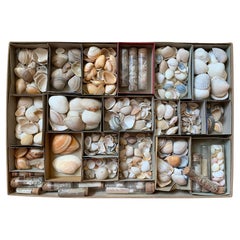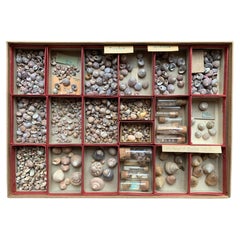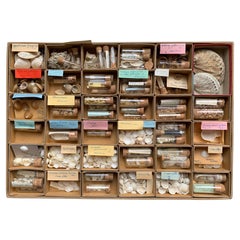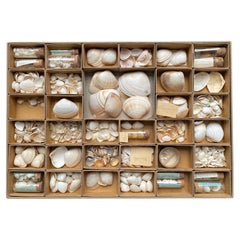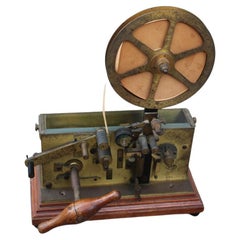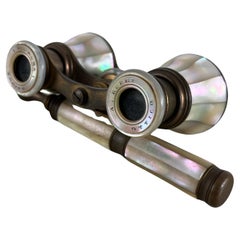European Scientific Instruments
to
89
787
295
1,107
2
123
98
46
45
36
25
24
18
15
12
7
6
6
6
3
3
1
1
117
462
528
2
264
177
29
19
37
27
25
13
25
22
10
5
620
511
326
186
119
1,109
386
262
235
182
1,109
1,109
1,109
8
6
4
4
3
Place of Origin: European
Curiosity Cabinet Naturalism Collection of Shell circa 1900
Located in Beuzevillette, FR
Very interesting set of shells collected by an amateur between the end of the 19th century and the beginning of the 20th century. The shells are classified by size and age either in ...
Category
Early 20th Century European Scientific Instruments
Materials
Shell
Curiosity Cabinet Naturalism Collection of Shell circa 1900
Located in Beuzevillette, FR
Very interesting set of shells collected by an amateur between the end of the 19th century and the beginning of the 20th century. The shells are classified by size and age either in ...
Category
Early 20th Century European Scientific Instruments
Materials
Shell
Curiosity Cabinet Naturalism Collection of Shell circa 1900
Located in Beuzevillette, FR
Very interesting set of shells collected by an amateur between the end of the 19th century and the beginning of the 20th century. The shells are classified by size and age either in ...
Category
Early 20th Century European Scientific Instruments
Materials
Shell
Curiosity Cabinet Collection of Shells, Circa 1900
Located in Beuzevillette, FR
Very interesting set of shells collected by an amateur between the end of the 19th century and the beginning of the 20th century. The shells are classified by size and age either in ...
Category
Early 20th Century European Scientific Instruments
Materials
Shell
Italian Telegraph in Solid Brass, 1880
Located in Palermo, Sicily
Italian Telegraph in solid brass, 1880.
Category
1880s Art Nouveau Antique European Scientific Instruments
Materials
Brass
$3,262 Sale Price
20% Off
Brass Lorgnettes 'Long-Handled Opera Glasses' Mid-Century Italian Design 1930s
Located in Palermo, IT
A splendid pair of 'lorgnettes' (long-handled opera, or theatre, glasses). Lorgnettes, eye glasses held in place by long handles rather than resting on the bridge of one's nose, were...
Category
1930s Vintage European Scientific Instruments
Materials
Brass
$447 Sale Price
20% Off
BMT 110 mm Binoculars
By Kazan
Located in Aspen, CO
BMT-110 Soviet Marine Binocular Telescope – 20x110mm Cold War Era Optics, Circa 1950s
Step into the history of Cold War surveillance and maritime observation with this rare Soviet B...
Category
20th Century European Scientific Instruments
Materials
Steel
$35,000
XIX Century English Mahogany Apothecary Set Cabinet Medicines J Hexam Chymist
Located in Milan, IT
English apothecary cabinet dated to the first half of the nineteenth century, mahogany box, brass handle and hinges and complete with key. The cabinet with a rectangular base is form...
Category
19th Century Antique European Scientific Instruments
Materials
Mahogany
Sputnik Space Age Table Weather Station, Relative Hygrometer, West Germany, 60s
Located in Antwerp, BE
Midcentury Modern Space Age Weather station made by Huger in the 60s, consisting of a thermometer, hygrometer and barometer made in West Germany the weather station is made of a chro...
Category
1960s Space Age Vintage European Scientific Instruments
Materials
Steel, Chrome
Intriguing Set of 4 Spanish Wooden Molds Used in Shaping Toile and Other Soft
Located in Round Top, TX
An intriguing set of 4 Spanish Wooden Molds used in shaping toile and other soft metals. A wonderful collection for any bookcase or table top. Super patin...
Category
Early 19th Century Antique European Scientific Instruments
Materials
Wood
Culpeper Compound Microscope
Located in New Orleans, LA
Compound Monocular Microscope
Edmund Culpeper
Circa 1730
This extraordinary early 18th-century microscope is a museum-worthy example of scientific innovation and craftsmanship made ...
Category
18th Century Antique European Scientific Instruments
Materials
Brass
$48,500
Antique maritime navy compass
Located in Banská Štiavnica, SK
Antique maritime navy compass in very nice original condition.
Category
19th Century Antique European Scientific Instruments
Materials
Brass
1950s Dutch Industrial Scientific Convex Lens Brass Stand Cast Iron Tripod Base
Located in Haarlem, NL
Scientific school or laboratory convex shaped lens on a brass stand with cast iron tripod base.
The heavy convex glass lens is 7 1/2 cm (2.95") th...
Category
1950s Vintage European Scientific Instruments
Materials
Metal, Brass, Iron
$760 Sale Price
20% Off
Carl Zeiss cold war era 10 x 50 periscope binoculars
By Carl Zeiss
Located in London, GB
A cold war era Carl Zeiss Oberkochen 10 x 50 periscope binoculars, German, circa 1965.
Specifications: 10 times magnification, coated optics, objective diameter 50 mm, grey filter and drop down grid.
Original transport case. (included protective feet pads and rubber eye guards).
Dimensions of the case: 29 x 18 1/2 x 11 inches. (73 x 47 x 28 cm).
Mounted on an adjustable height tripod. Height of periscope in photographs: 77 inches.
This model of Zeiss periscope...
Category
Mid-20th Century Industrial European Scientific Instruments
Materials
Aluminum, Brass, Steel
Vintage Handmade Egg Timer Hourglass in Wooden Textile Bobbin Spool 3min Timer
Located in Bishop's Stortford, GB
Vintage Handmade Egg Timer Hourglass in Wooden Textile Bobbin Spool 3min Timer. Crafted with precision, the hourglass features fine sand that flows smoothly, symbolizing the passage ...
Category
Early 20th Century Victorian European Scientific Instruments
Materials
Glass
Copper & brass fuel measures by Sutherland Astell
Located in London, GB
Two copper and brass metric "Checkpump" fuel measures by Sutherland Astell, circa 1950.
Made for the County Borough of Blackpool.
Marked: 10 and 20 litres, at 20°.
20L, Height: 23...
Category
Mid-20th Century European Scientific Instruments
Materials
Brass, Copper
Brass compass with mother of pearl dial from WW1 period , English circa 1914
Located in Central England, GB
This superb example of an early 20th century heavy folding brass compass is of a design and type often issued to officers in the First World War.
This fine example is not marked for...
Category
Early 20th Century Other European Scientific Instruments
Materials
Brass
Antique English Folding Brass Linen Thread Counter c.1920
Located in Bath, GB
Dating to the early twentieth century, c.1900/1920, this is an antique cast brass linen thread counter, of course usable to magnify whatever you wish.
Heavy solid cast brass with a ...
Category
1920s Vintage European Scientific Instruments
Materials
Brass
Antique Working English Cast Iron Cheese Press Thomas Corbett of Shrewsbury 1880
Located in Portland, OR
A rare antique and all original fully functioning cast iron English cheese press, by Thomas Corbett of Shrewsbury, circa 1880. This cheese press has just ...
Category
1880s Industrial Antique European Scientific Instruments
Materials
Iron
$3,680 Sale Price
20% Off
Curiosity Cabinet Naturalism Collection of Shell circa 1900
Located in Beuzevillette, FR
Very interesting set of shells collected by an amateur between the end of the 19th century and the beginning of the 20th century. The shells are classified by size and age either in ...
Category
Early 20th Century European Scientific Instruments
Materials
Shell
Curiosity Cabinet Naturalism Collection of Shell, Circa 1900
Located in Beuzevillette, FR
Very interesting set of shells collected by an amateur between the end of the 19th century and the beginning of the 20th century. The shells are classified by size and age either in ...
Category
20th Century European Scientific Instruments
Materials
Shell
French Barometer Gilt Wood Verre Eglomise
Located in Bradenton, FL
19th century French Giltwood and Verre Eglomise Barometer. The barometer frame is richly decorated with bouquets of flowers, vine branches, shells and palm leaves. The Eglomisé Dial ...
Category
19th Century Charles X Antique European Scientific Instruments
Materials
Stucco, Giltwood
$1,800 / item
Italian Modern Wooden Botanic Model
By Robert Brendel
Located in Roma, IT
A botanic didactical specimen in the manner of the famous German botanist Robert Brendel.
"In the late 19th century Robert Brendel and his son Reinhold produced beautiful and accur...
Category
Mid-20th Century Mid-Century Modern European Scientific Instruments
Materials
Wood
French Late 19th Century Bronze Armillary Sphere Depicting the Titan Atlas
Located in Atlanta, GA
A French bronze armillary sphere depicting Atlas carrying the world from the late 19th century with verdigris patina. Created in France during the last quarter of the 19th century, t...
Category
Late 19th Century Antique European Scientific Instruments
Materials
Bronze
Curiosity Cabinet Naturalism Collection of Shell Circa 1900
Located in Beuzevillette, FR
Very interesting set of shells collected by an amateur between the end of the 19th century and the beginning of the 20th century. The shells are classified by size and age either in ...
Category
Early 20th Century European Scientific Instruments
Materials
Shell
Nineteenth Century Hanging Bronze Scales with Nested Six Weights, 21-in high
Located in Fayetteville, AR
Standing at 21 inches in height, this set of large late nineteenth century French solid brass scales features two hanging brass pans that hang from chains. Six accompanying gram wei...
Category
Late 19th Century Antique European Scientific Instruments
Materials
Bronze
Antique Colmont French FT Binoculars Leather Paris
By Lawrence and Mayo
Located in Chula Vista, CA
AMBIANIC presents
Vintage Colmont FT Paris binoculars
Colmont a French optical company known for producing high-quality binoculars
leather-covered body
maker stamp present
7.75 x 5 ...
Category
Early 20th Century Victorian European Scientific Instruments
Materials
Metal
Male anatomical model in painted stuccoed fiber. First half of the 20th century.
Located in Leuven , BE
Male anatomical model in painted stuccoed fiber. First half of the 20th century. Beautiful patina. Height: 30 cm.
Category
Early 20th Century European Scientific Instruments
Materials
Natural Fiber, Parchment Paper
Antique Officer of the Watch Telescope, English, Terrestrial, Astronomical, Ross
Located in Hele, Devon, GB
This is an antique officer of the watch telescope. An English, leather and nickel silver single draw refractor for terrestrial or astronomical use, by Ross of London, circa 1920.
...
Category
Late 19th Century Antique European Scientific Instruments
Materials
Leather
Vintage Sheaffer Fountain Pen, circa 1950
By Montblanc
Located in Barcelona, ES
Sheaffer fountain pen, circa 1950. Manufactured by Sheaffers In original condition, with some visible signs of previous use and age, preserving a beautiful patina. Materials...
Category
1950s Mid-Century Modern Vintage European Scientific Instruments
Materials
Metal
$403 Sale Price
77% Off
19th c. Bock-Steger Anatomical Brain Model, Germany
Located in San Francisco, CA
ABOUT
A hand crafted and painted plaster anatomical model of the human brain. Franz Josef Steger and pathological anatomist Carl Ernst Bock collaborated a...
Category
19th Century Victorian Antique European Scientific Instruments
Materials
Plaster
$450 Sale Price
78% Off
Greta Garbo Limited Edition Mont Blanc Ballpoint Pen with Pearl
By Montblanc
Located in North Hollywood, CA
Greta Garbo Limited Edition Mont Blanc Ballpoint Rollerball pen with pearl.
Montblanc honors Greta Garbo in the form of another mystical writing i...
Category
Late 20th Century Art Deco European Scientific Instruments
Materials
Resin
19th Century Italian Carved Louis XVI Style Giltwood Barometer
Located in Rio Vista, CA
Gorgeous late 19th century gilt wood barometer thermometer made in Italy in the Louis XVI or baroque taste. The large barometer features a large carve...
Category
19th Century Louis XVI Antique European Scientific Instruments
Materials
Metal, Brass
Curiosity Cabinet Naturalism Collection of Shells Circa 1900
Located in Beuzevillette, FR
Very interesting set of shells collected by an amateur between the end of the 19th century and the beginning of the 20th century. The shells are classified by size and age either in ...
Category
Early 20th Century European Scientific Instruments
Materials
Shell
1880 Earnst Plank Magic Lantern, Box Plus 72 Slides
Located in Peekskill, NY
This is a beautiful and decorative 1800 magic lantern full boxed set. It was created by Ernst Plank and each slide box is signed. It comes with an amazing ...
Category
Late 19th Century Victorian Antique European Scientific Instruments
Materials
Glass
Antique 3 Draw Telescope, English Brass, Terrestrial Instrument, Victorian, 1880
Located in Hele, Devon, GB
Perfect for bird watching, landscape appreciation, wildlife, or maritime observation. Equally suitable for observing the night sky.
This is an antique 3-draw telescope. An English, ...
Category
1880s Late Victorian Antique European Scientific Instruments
Materials
Brass
Antique English Folding Brass Magnifying Glass c.1910
Located in Bath, GB
A brass folding pocket magnifying glass which is made also to be added to a chain or ribbon to be worn around the neck.
The lens has a good magnification and in lovey condition.
D...
Category
1910s Edwardian Vintage European Scientific Instruments
Materials
Brass
French Wooden Scale, Late 19th-Early 20th Century
Located in Atlanta, GA
Having a large weighing surface and a smaller side for weights.
Category
Early 20th Century European Scientific Instruments
French Louis XVI Style Bronze Barometer
Located in Queens, NY
French Louis XVI-style bronze wall barometer with an urn finial top with a head above the round dial and draped with a ribbon design.
Category
20th Century Louis XVI European Scientific Instruments
Materials
Bronze
Ptolemaic Armillary Sphere, Charles-François Delamarche, Paris, ante 1798
By Charles Francois Delamarche
Located in Milano, IT
Ptolemaic armillary sphere
Charles-François Delamarche
Paris, ante 1798
Wood and papier-mâché
covered with printed and partly hand-colored paper
It measures 16.37 in in height x Ø 10.94 in (41.60 cm - Ø 27.80 cm)
It weights 2.33 lb (1,058 g)
State of conservation: consistent with its age and use, the paper shows some signs of use, stains and abrasions.
The sphere is Ptolemaic, with the Earth placed at its center, surrounded by the Moon and the Sun mounted on two metal arms.
The sphere is composed of six horizontal and two vertical rings (armillae), each bearing graduations and its own name.
The first horizontal ring is illegible. The others, in descending order are: North Pole, Tropic of Cancer, Equator, Tropic of Capricorn, South Pole.
The vertical rings consist of two double meridians.
The sphere is then connected to the large meridian by two pins, a vertical ring inserted perpendicularly into the circle of the Horizon, in turn supported by four semicircles connected to the turned and black-stained wooden base.
Each element is covered with printed paper. It contains various pieces of information: latitudes, length of days, names and zodiac symbols, calendar, wind directions, etc.
The vertical circles mention the latitudes and longitudes of different cities: Rome, Bordeaux, Madrid, Boston, Batavia (Jakarta), Acapulco, etc.
Even the small terrestrial globe is covered with printed paper: continents and oceans appear with numerous geographical markings indicating the most recent explorations.
In the Pacific Ocean, west of South America bears the following inscription:
GLOBE
TERRESTRIAL
à Paris
chez Delamarche Géog
Rue du Foin Jacques
Au Collège de
M.e Gervais
The North American coasts are well delineated and California appears correctly as a peninsula - reports from Spanish explorers in the region had given rise to confusion as to whether it was connected to the mainland or not. The geographical nature of California was confirmed after the explorations of Juan Bautista de Anza (1774-1776).
Alaska is not described and is only partially traced; it would become part of the United States in 1867.
Various Pacific islands are indicated.
Australia (the name definitely used from 1824) is called "Nouvelle Hollande."
Tasmania is still represented as a peninsula and this is an important detail for the dating of our armillary sphere.
The island is separated from Australia by Bass Strait, which was crossed by Matthew Flinders for the first time in 1798, showing that it was not a peninsula. Delamarche certainly would not have waited a long time to update such an important geographical datum: presumably he did so shortly after receiving the news.
Charles-François Delamarche (1740-1817) founded his laboratory around 1770 and, in a few years, he became the most famous French cartographer and globe maker between the 18th and 19th centuries. After having acquired the laboratory of the late Didier Robert de Vaugondy (1723-1786; himself a renowned cartographer who continued the family business founded by his grandfather Nicolas Sanson in the seventeenth century) and after having purchased, between 1788 and around 1800, the businesses of Jean-Baptiste Fortin (1750-1831) and Jean Lattré (around 1750-1800), he began to call himself "Successeur de MM. Sanson and Robert de Vaugondi, Géographes du Roi and de M. Fortin, Ingénieur-mécanicien du Roi pour les globes et les sphères."
Thus, at the end of the eighteenth century, Delamarche possessed the warehouse stocks, as well as the manufacturing skills of the globes of his main rivals in Paris.
In addition to this aggressive acquisition policy, the key to its success also lay in the combination of high-quality cartography combined with extremely attractive globes and armillary spheres; and, of course, its famous red paint finishing touch.
His laboratory was located on Rue de Foin St Jacques "au Collège Me. (or "Mtre") Gervais" in the Latin Quarter of Paris until around 1805, when he moved to rue du Jardinet No. 13.
On the death of Charles-François in 1817, the reins of the company passed to his son Félix (1779-1835), who continued to publish, often in collaboration with the engraver Charles Dien, Sr. In 1835 the company first moved to rue du Jardinet No. 12 and a little later to rue du Battoir No. 7.
Bibliography:
Dekker, Elly, et al. Globes at Greenwich...
Category
1790s Other Antique European Scientific Instruments
Materials
Wood, Paper
19th Century German Miniature Pocket Terrestrial Globe
By C. Abel-Klinger
Located in Essex, MA
A miniature 19th century 3.5 inch diameter pocket terrestrial globe by C. Abel-Klinger, Nuremberg, Germany, in English for the English speaking markets. Signed with cartouche reading...
Category
1880s Antique European Scientific Instruments
Materials
Brass
$1,230 Sale Price
50% Off
Rare 18th Century Equatorial Sundial And Compass By Johann Nepomuk Schrettegger
Located in Bilzen, BE
"Rare 18th Century Equatorial Sundial And Compass By Johann Nepomuk Schrettegger,"
Rare 18th-Century Equinoctial Sundial & Compass by Johann Nepomuk Schrettegger, Augsburg
Maker: Joh...
Category
18th Century Louis XVI Antique European Scientific Instruments
Materials
Brass
Pair of English 12-inch Globes by William Harris, London, 1832 and 1835
By William Harris
Located in Milano, IT
Pair of 12-inch table globes
William Harris
London, 1832 and 1835
Slight abrasions from use; few cracks
lb 11 each (kg 5)
The two terrestrial and celestial globes rest in their original Dutch style stands with four supporting turned wood columns.
Each one measures 12 in in height x 16.5 in in diameter with the diameter of the spheres measuring approximately 12 in; 48 cm in height x 42 cm in diameter x 31 cm diameter of the spheres.
The 12 inch measure was the most frequently used by British manufacturers of globes of this period.
Each globe is composed of two series of twelve printed paper gores, aligned and glued onto plaster spheres.
The brass circle of the meridian bears engravings...
Category
1830s William IV Antique European Scientific Instruments
Materials
Paper, Wood
Five 19th C. French Bronze Metric (Apothecary ) Weights, Original Wooden Block
Located in West Palm Beach, FL
Set of 5 Antique French Bronze (Apothecary) Metric Weights with Original Wooden Block, Circa 1880
A handsome and authentic set of 19th-century French bronze metric weights, housed i...
Category
Late 19th Century Industrial Antique European Scientific Instruments
Materials
Bronze
Impressive Antique Brass Dolland & Co. Telescope With Case for Restoration
By Dolland
Located in Bridgeport, CT
Large antique Dolland & Co brass telescope with labeled wood box with accessories as shown. Engraved brass lens G. Dollond, London. Comes with tall wooden stand or smaller brass tri...
Category
19th Century Antique European Scientific Instruments
Materials
Brass
Antique Victorian Quality Carved Oak Banjo Barometer
Located in Suffolk, GB
Antique Victorian quality carved oak banjo barometer having a quality carved oak shaped case with a brass bezel, porcelain dial with original hands and a thermometer
An attractive ...
Category
19th Century Victorian Antique European Scientific Instruments
Materials
Oak
Antique Vineyard Setter's Compass, French, Brass, Surveyor's Instrument, C.1900
Located in Hele, Devon, GB
This is an antique vineyard setter's compass. A French, brass surveyor's instrument with mahogany case and stand, dating to the late Victorian period, c...
Category
Late 19th Century Antique European Scientific Instruments
Materials
Brass
Automa Tedesco Gabbia Con Uccello Cantante e Animato 1920s Karl Griesbaum
By Karl Griesbaum
Located in Milano, MI
Automa Animato Tedesco Gabbia Con Uccellino del 1920 circa costituito da una gabbia rotonda in ottone dorato con al suo interno un uccello animato canterino su di un trespolo con un ...
Category
Early 19th Century Art Deco Antique European Scientific Instruments
Materials
Brass
Antique Technical Drawing Set, German, Architect, Cartography, Wichmann
Located in Hele, Devon, GB
This is an antique technical drawing set. A German, architect's or cartographer's instrument case by Wichmann, dating to the early 20th c...
Category
Early 20th Century Edwardian European Scientific Instruments
Materials
Nickel
18th Century French Louis XVI Period Gilded Barometer by Evangelista Torricelli
By Evangelista Torricelli
Located in West Palm Beach, FL
A gold, large antique French Louis XVI period barometer, signed by Torricelli in gilded wood and of oval shape with original scientific illustrations, in good condition. The detailed wall décor piece is consisting its original glass. Framed with gilt foliate trim and important pediment. Minor fading, due to age. Wear consistent with age and use, circa 1750, France.
The Italian scientist Evangelista Torricelli...
Category
Late 18th Century Louis XVI Antique European Scientific Instruments
Materials
Giltwood
Large Arts & Crafts Hand-Carved Nutwood Barometer with Thermometer, Early 1900s
Located in Lisse, NL
This rare and decorative early 20th-century Arts & Crafts wall barometer and thermometer is a striking testament to Dutch craftsmanship. Hand-carved from a single solid piece of rich...
Category
Early 20th Century Arts and Crafts European Scientific Instruments
Materials
Metal, Brass
Antique French Lorgnette Binoculars or Opera Glasses in Brass & Mother of Pearl
By LeRoy
Located in Hamilton, Ontario
This pair of antique lorgnette opera glasses were made by LeRoy of France in approximately 1880 in the period Victorian style. These bi...
Category
Late 19th Century Victorian Antique European Scientific Instruments
Materials
Brass
Early 20th-Century English Sovereign Balance Scale by Harrison
Located in Atlanta, GA
This early 20th-century English sovereign balance scale, marked “Harrison”, was designed to verify the weight and authenticity of full and half sovereign gold coins. A finely crafted piece of precision engineering, it features a brass balance arm with two coin slots labeled “Sovereign Warranted” and “Sovereign ½”, ensuring accurate weight measurement. The base, also inscribed with “Harrison” and adorned with a crowned hallmark, reflects its quality craftsmanship.
These compact, mechanical scales were widely used by bankers, jewelers, and traders during the early 1900s to prevent fraud and counterfeit currency circulation. Their simple yet effective design remains a testament to the ingenuity of the time.
A rare and collectible piece of British numismatic history, this scale is perfect for collectors of antique measuring...
Category
20th Century European Scientific Instruments
Materials
Brass
English Regency Gilt Figural and Ebonized Dital Harp, Maker E. Light, Circa 1815
Located in Charleston, SC
English Regency gilt stenciled figural and floral ebonized dital harp signed by maker Edward Light. Retailed at Srohl Foley place London, Early 19th century.
Category
1810s Regency Antique European Scientific Instruments
Materials
String, Wood, Ebony, Giltwood
Pair of Antique Opera Glasses, English, Leather, Brass, Binoculars, Ross London
Located in Hele, Devon, GB
This is a pair of antique opera glasses. An English, leather and brass binocular by Ross of London, dating to the early 20th century, circa 1920.
A charming and original example of ...
Category
1920s Edwardian Vintage European Scientific Instruments
Materials
Brass
Old Compass reproduction 1944 London, brown Color
Located in Auribeau sur Siagne, FR
Old Compass reproduction 1944 London, brown Color
Category
20th Century European Scientific Instruments
Materials
Metal
$130 Sale Price
20% Off
French Wooden and Iron Cheese Press, circa 1900
Located in Atlanta, GA
Having a double trestle base and a threaded press, the surface with a raised edge and a drain spout.
Category
Early 1900s Antique European Scientific Instruments
Sinar P Expert Kit Large Format 4X5
Located in valatie, NY
Sinar p 4x5 expert kit containing:
Sinar copal f5.6 auto aperture shutter & release cable
Sinar p 4x5 camera
Regular bellows
Wide angle bellows
4x5 g...
Category
1980s Vintage European Scientific Instruments
Materials
Aluminum
$9,750 / set
English Pocket Globe, London, Circa 1775-1798
By Herman Moll
Located in Milano, IT
Pocket globe
London, between 1775 and 1798
Re-edition of the globe of Hermann Moll (1678-1732) dated 1719
The globe is contained in its original case, which itself is covered in shark skin.
There are slight gaps in the original paint on the sphere. The case no longer closes.
The sphere measures 2.7 in (7 cm) in diameter whereas the case measures 2.9 in (7.4 cm) in diameter.
lb 0.22 (kg 0.1)
The globe is made up of twelve printed paper gores aligned and glued to the sphere.
In the North Pacific Ocean there is a cartouche with the inscription:
A Correct
Globe
with the new
Discoveries.
The celestial globe is depicted on the inside of the box and is divided into two hemispheres with the cartouche:
A correct globe
with ye new cons
relations of Dr.
Halley & c.
It shows the ecliptic divided into the days of the zodiacal calendar and the constellations represented as animals and mythological figures.
On the globe are delineated the equinoctial line, divided by degrees and hours, the ecliptic and the meridian (passing west of Greenwich). The continents are shaded and outlined in pink, green and yellow. It shows: the Cook routes; a wind rose in the Southern Indian Ocean; Antarctica without land; Africa with Negroland (Hermann Moll is considered the first geographer to name the West African region in his 1727 map. (Encyclopaedia Britannica, ed. 1902, under "States of Central Africa"); Tartary in Central Asia; the Mogul kingdom in northern India; in North America only New England, Virginia, Carolina, Florida, Mississippi are identified; California is already a peninsula; the northwest coast of America is "unknown parts" (Alaska is not described and it is only partially delineated, it was to become part of the United States in 1867); Mexico is named "Spain"; Central South America "Amazone America". Australia (which was to be so named after 1829) is called New Holland. The route of Admiral Anson is traced (1740) and the trade winds are indicated by arrows. (See Van der Krogt, P., Old Globes in the Netherlands, Utrecht 1984, p. 146 and Van der Krogt, P. - Dekker, E., Globes from the Western World, London 1993, pp. 115.)
Elly Dekker, comparing Moll’s 1719 globe and his re-edition (of which the one described above is a sample), identifies the differences between them: the two editions are quite similar to each other, but in the "anonymous" globe, compared to the previous globe of 1719, California looks like a proper peninsula - the reports of the Spanish explorers of the region had given rise to uncertainty over whether it was connected to the mainland or not. The geographical nature of California was confirmed after the explorations of Juan Bautista de Anza (1774-1776). The routes of Dampier's journey were partially erased and the route of Captain James Cook's first voyage was superimposed on them, and the geography of Australasia was adapted accordingly, including the denomination of the Cook Strait. See Dekker, Elly, Globes at Greenwich, 1999.
An important ante quem element is represented by Tasmania: it is not separated from Australia by the Bass Strait...
Category
Late 18th Century George III Antique European Scientific Instruments
Materials
Shagreen, Paper
A Fine Adams, London Culpepper Microscope
Located in Lincolnshire, GB
A late 18th century brass lacquered Culpepper design microscope by Adams, London in the original mahogany case. The two drawers contain a good selection of lenses and accessories.
Th...
Category
Late 18th Century Antique European Scientific Instruments
Materials
Brass
Recently Viewed
View AllMore Ways To Browse
Library Telescope
Torricelli Barometer
Antique Butcher Hook
Antique Cast Iron Weighing Scales
Antique Medical Box
Antique Medical Devices
Antique Metal Wood Planes
Antique Syringes
Antique Wooden Grinder
Avery Scales
German Sundial
Surveyors Box
Used Dental Instrument
Vintage Molecular Model
Barometer Lyre
Binoculars Midcentury
Wax Anatomical Model
1960s Barometer
